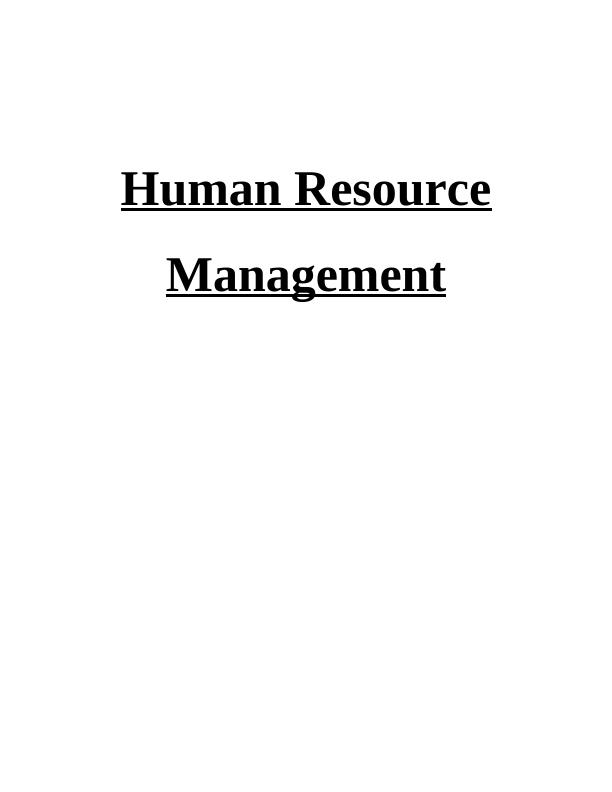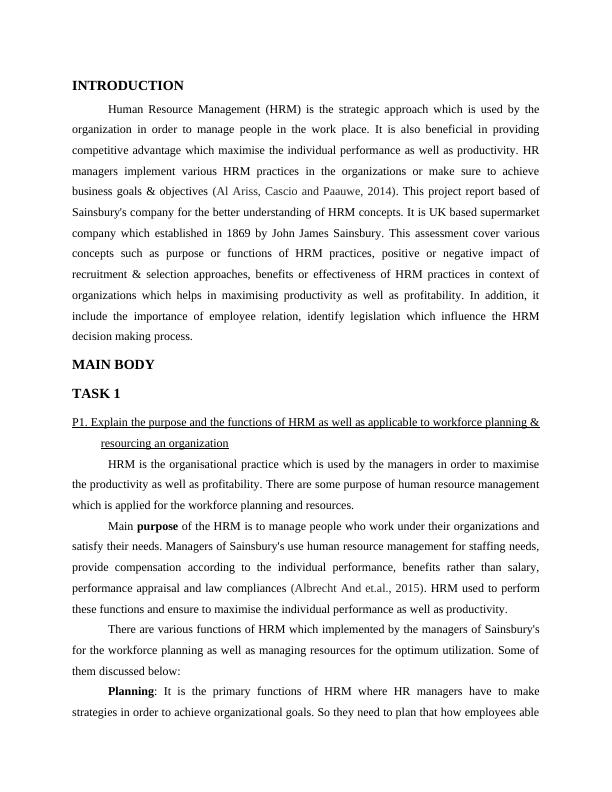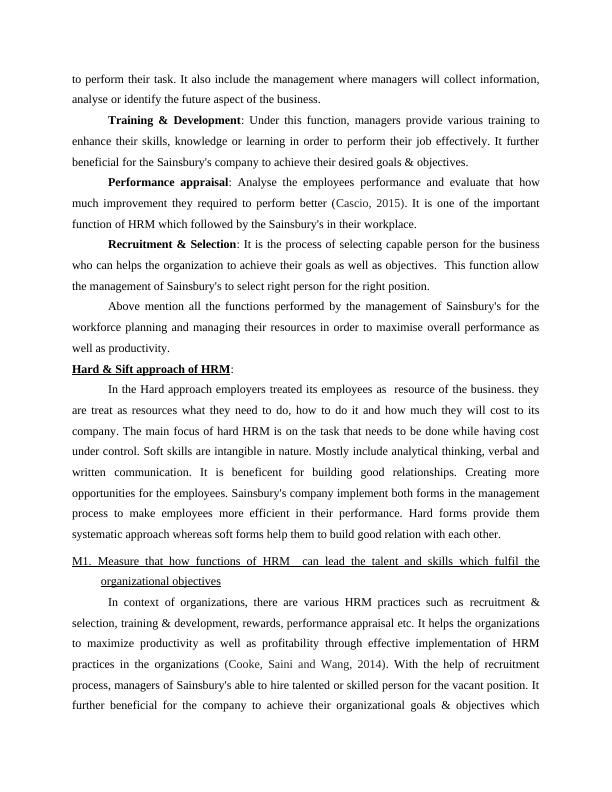Benefits and Effectiveness of HRM Practices in Organizations
15 Pages4675 Words83 Views
Added on 2023-01-18
About This Document
This document discusses the purpose and functions of HRM in workforce planning and resourcing an organization. It evaluates the strengths and weaknesses of different approaches to recruitment and selection. It also explores the benefits of HRM practices for employers and employees, as well as their effectiveness in maximizing productivity and profitability. The document includes a case study of Sainsbury's company.
Benefits and Effectiveness of HRM Practices in Organizations
Added on 2023-01-18
ShareRelated Documents
Human Resource
Management
Management

Table of Contents
INTRODUCTION...........................................................................................................................4
MAIN BODY...................................................................................................................................4
TASK 1............................................................................................................................................4
P1. Explain the purpose and the functions of HRM as well as applicable to workforce planning
& resourcing an organization.......................................................................................................4
M1. Measure that how functions of HRM can lead the talent and skills which fulfil the
organizational objectives.............................................................................................................5
P2. Evaluate the strength & weakness of different approaches to recruitment and selection.....6
M2. Critically evaluate the strength and weakness of different recruitment process..................7
TASK 2 ...........................................................................................................................................7
P3. Evaluate the benefits of different HRM practices in the organizations for employer as well
as employee..................................................................................................................................7
P4. Evaluate the effectiveness of various HRM practices which helps in maximising
productivity as well as profitability of the company ..................................................................8
M3. Investigate the different methods of HRM practices along with specific example in
context of business.......................................................................................................................9
TASK 3............................................................................................................................................9
P5. Analyse the importance of employee relation which can influence HRM decision making
process..........................................................................................................................................9
P6. Identify the key elements of employment legislation and its impact on HRM decision-
making process...........................................................................................................................10
M4. Assess the key aspects of employee relations management and employment legislation
which affect the HRM decision-making in context of organisational.......................................11
TASK 4..........................................................................................................................................11
P7. Elaborate the application of HRM practices in a work-related context along with specific
examples....................................................................................................................................11
M5. Provide a explanation for the application of specific HRM practices in context of work. 14
CONCLUSION..............................................................................................................................15
REFERENCES .............................................................................................................................16
INTRODUCTION...........................................................................................................................4
MAIN BODY...................................................................................................................................4
TASK 1............................................................................................................................................4
P1. Explain the purpose and the functions of HRM as well as applicable to workforce planning
& resourcing an organization.......................................................................................................4
M1. Measure that how functions of HRM can lead the talent and skills which fulfil the
organizational objectives.............................................................................................................5
P2. Evaluate the strength & weakness of different approaches to recruitment and selection.....6
M2. Critically evaluate the strength and weakness of different recruitment process..................7
TASK 2 ...........................................................................................................................................7
P3. Evaluate the benefits of different HRM practices in the organizations for employer as well
as employee..................................................................................................................................7
P4. Evaluate the effectiveness of various HRM practices which helps in maximising
productivity as well as profitability of the company ..................................................................8
M3. Investigate the different methods of HRM practices along with specific example in
context of business.......................................................................................................................9
TASK 3............................................................................................................................................9
P5. Analyse the importance of employee relation which can influence HRM decision making
process..........................................................................................................................................9
P6. Identify the key elements of employment legislation and its impact on HRM decision-
making process...........................................................................................................................10
M4. Assess the key aspects of employee relations management and employment legislation
which affect the HRM decision-making in context of organisational.......................................11
TASK 4..........................................................................................................................................11
P7. Elaborate the application of HRM practices in a work-related context along with specific
examples....................................................................................................................................11
M5. Provide a explanation for the application of specific HRM practices in context of work. 14
CONCLUSION..............................................................................................................................15
REFERENCES .............................................................................................................................16

INTRODUCTION
Human Resource Management (HRM) is the strategic approach which is used by the
organization in order to manage people in the work place. It is also beneficial in providing
competitive advantage which maximise the individual performance as well as productivity. HR
managers implement various HRM practices in the organizations or make sure to achieve
business goals & objectives (Al Ariss, Cascio and Paauwe, 2014). This project report based of
Sainsbury's company for the better understanding of HRM concepts. It is UK based supermarket
company which established in 1869 by John James Sainsbury. This assessment cover various
concepts such as purpose or functions of HRM practices, positive or negative impact of
recruitment & selection approaches, benefits or effectiveness of HRM practices in context of
organizations which helps in maximising productivity as well as profitability. In addition, it
include the importance of employee relation, identify legislation which influence the HRM
decision making process.
MAIN BODY
TASK 1
P1. Explain the purpose and the functions of HRM as well as applicable to workforce planning &
resourcing an organization
HRM is the organisational practice which is used by the managers in order to maximise
the productivity as well as profitability. There are some purpose of human resource management
which is applied for the workforce planning and resources.
Main purpose of the HRM is to manage people who work under their organizations and
satisfy their needs. Managers of Sainsbury's use human resource management for staffing needs,
provide compensation according to the individual performance, benefits rather than salary,
performance appraisal and law compliances (Albrecht And et.al., 2015). HRM used to perform
these functions and ensure to maximise the individual performance as well as productivity.
There are various functions of HRM which implemented by the managers of Sainsbury's
for the workforce planning as well as managing resources for the optimum utilization. Some of
them discussed below:
Planning: It is the primary functions of HRM where HR managers have to make
strategies in order to achieve organizational goals. So they need to plan that how employees able
Human Resource Management (HRM) is the strategic approach which is used by the
organization in order to manage people in the work place. It is also beneficial in providing
competitive advantage which maximise the individual performance as well as productivity. HR
managers implement various HRM practices in the organizations or make sure to achieve
business goals & objectives (Al Ariss, Cascio and Paauwe, 2014). This project report based of
Sainsbury's company for the better understanding of HRM concepts. It is UK based supermarket
company which established in 1869 by John James Sainsbury. This assessment cover various
concepts such as purpose or functions of HRM practices, positive or negative impact of
recruitment & selection approaches, benefits or effectiveness of HRM practices in context of
organizations which helps in maximising productivity as well as profitability. In addition, it
include the importance of employee relation, identify legislation which influence the HRM
decision making process.
MAIN BODY
TASK 1
P1. Explain the purpose and the functions of HRM as well as applicable to workforce planning &
resourcing an organization
HRM is the organisational practice which is used by the managers in order to maximise
the productivity as well as profitability. There are some purpose of human resource management
which is applied for the workforce planning and resources.
Main purpose of the HRM is to manage people who work under their organizations and
satisfy their needs. Managers of Sainsbury's use human resource management for staffing needs,
provide compensation according to the individual performance, benefits rather than salary,
performance appraisal and law compliances (Albrecht And et.al., 2015). HRM used to perform
these functions and ensure to maximise the individual performance as well as productivity.
There are various functions of HRM which implemented by the managers of Sainsbury's
for the workforce planning as well as managing resources for the optimum utilization. Some of
them discussed below:
Planning: It is the primary functions of HRM where HR managers have to make
strategies in order to achieve organizational goals. So they need to plan that how employees able

to perform their task. It also include the management where managers will collect information,
analyse or identify the future aspect of the business.
Training & Development: Under this function, managers provide various training to
enhance their skills, knowledge or learning in order to perform their job effectively. It further
beneficial for the Sainsbury's company to achieve their desired goals & objectives.
Performance appraisal: Analyse the employees performance and evaluate that how
much improvement they required to perform better (Cascio, 2015). It is one of the important
function of HRM which followed by the Sainsbury's in their workplace.
Recruitment & Selection: It is the process of selecting capable person for the business
who can helps the organization to achieve their goals as well as objectives. This function allow
the management of Sainsbury's to select right person for the right position.
Above mention all the functions performed by the management of Sainsbury's for the
workforce planning and managing their resources in order to maximise overall performance as
well as productivity.
Hard & Sift approach of HRM:
In the Hard approach employers treated its employees as resource of the business. they
are treat as resources what they need to do, how to do it and how much they will cost to its
company. The main focus of hard HRM is on the task that needs to be done while having cost
under control. Soft skills are intangible in nature. Mostly include analytical thinking, verbal and
written communication. It is beneficent for building good relationships. Creating more
opportunities for the employees. Sainsbury's company implement both forms in the management
process to make employees more efficient in their performance. Hard forms provide them
systematic approach whereas soft forms help them to build good relation with each other.
M1. Measure that how functions of HRM can lead the talent and skills which fulfil the
organizational objectives
In context of organizations, there are various HRM practices such as recruitment &
selection, training & development, rewards, performance appraisal etc. It helps the organizations
to maximize productivity as well as profitability through effective implementation of HRM
practices in the organizations (Cooke, Saini and Wang, 2014). With the help of recruitment
process, managers of Sainsbury's able to hire talented or skilled person for the vacant position. It
further beneficial for the company to achieve their organizational goals & objectives which
analyse or identify the future aspect of the business.
Training & Development: Under this function, managers provide various training to
enhance their skills, knowledge or learning in order to perform their job effectively. It further
beneficial for the Sainsbury's company to achieve their desired goals & objectives.
Performance appraisal: Analyse the employees performance and evaluate that how
much improvement they required to perform better (Cascio, 2015). It is one of the important
function of HRM which followed by the Sainsbury's in their workplace.
Recruitment & Selection: It is the process of selecting capable person for the business
who can helps the organization to achieve their goals as well as objectives. This function allow
the management of Sainsbury's to select right person for the right position.
Above mention all the functions performed by the management of Sainsbury's for the
workforce planning and managing their resources in order to maximise overall performance as
well as productivity.
Hard & Sift approach of HRM:
In the Hard approach employers treated its employees as resource of the business. they
are treat as resources what they need to do, how to do it and how much they will cost to its
company. The main focus of hard HRM is on the task that needs to be done while having cost
under control. Soft skills are intangible in nature. Mostly include analytical thinking, verbal and
written communication. It is beneficent for building good relationships. Creating more
opportunities for the employees. Sainsbury's company implement both forms in the management
process to make employees more efficient in their performance. Hard forms provide them
systematic approach whereas soft forms help them to build good relation with each other.
M1. Measure that how functions of HRM can lead the talent and skills which fulfil the
organizational objectives
In context of organizations, there are various HRM practices such as recruitment &
selection, training & development, rewards, performance appraisal etc. It helps the organizations
to maximize productivity as well as profitability through effective implementation of HRM
practices in the organizations (Cooke, Saini and Wang, 2014). With the help of recruitment
process, managers of Sainsbury's able to hire talented or skilled person for the vacant position. It
further beneficial for the company to achieve their organizational goals & objectives which

End of preview
Want to access all the pages? Upload your documents or become a member.
Related Documents
Human Resource Management Unit 3- HRM Practices in an Organisationlg...
|15
|3942
|459
Benefits of HRM Practices for Employer and Employeelg...
|14
|4069
|39
Function of Human Resource Management Assignmentlg...
|12
|3084
|14
Human Resource Management Practices in an Organisationlg...
|26
|9180
|427
Human Resources Management - Assignmentlg...
|12
|4224
|47
Human Resource Management - Sainsbury Assignmentlg...
|19
|4585
|35
